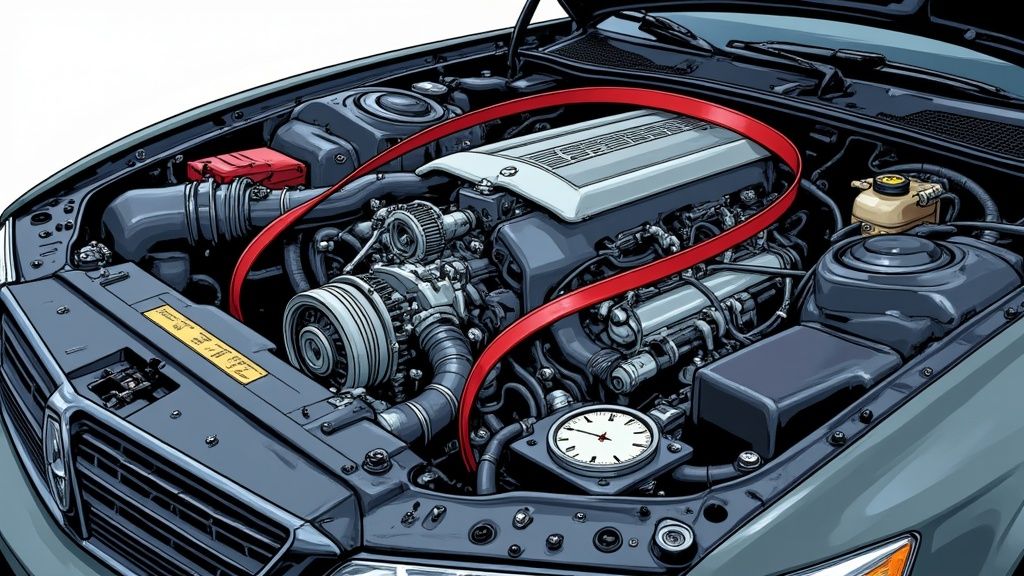
When to Replace Timing Belt: Avoid Engine Damage
Understanding Timing Belts: The Engine’s Critical Heartbeat
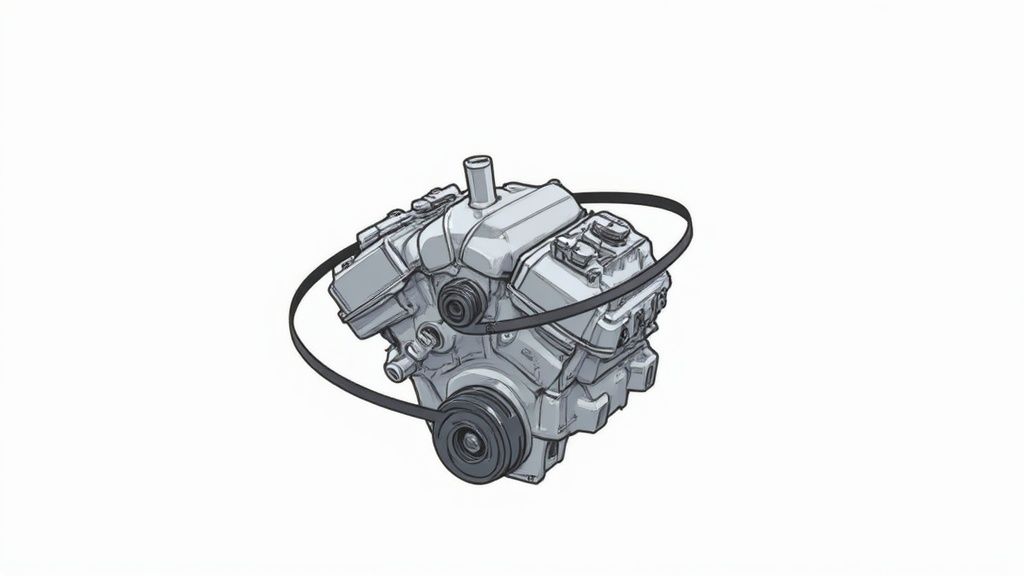
The timing belt is a critical component often overlooked until a problem arises. Essential for smooth engine operation, it orchestrates the precise synchronization between the crankshaft and camshaft. This ensures the engine’s valves open and close at the right time, a process vital for combustion and power generation.
From Rubber Bands To Reinforced Composites: Timing Belt Evolution
Timing belts have undergone a significant transformation. Early versions, simple rubber strips, were susceptible to wear and tear. Modern timing belts, however, utilize fiber-reinforced compounds for increased durability and lifespan.
High-strength fibers like Kevlar enhance tensile strength and resistance to stretching. Precise molding and curing techniques further ensure consistent performance and longevity in demanding engine environments. Despite these advancements, timing belts still have a limited lifespan and require periodic replacement.
The Silent Threat of Timing Belt Degradation
A deteriorating timing belt often goes unnoticed, unlike other engine components that provide audible warnings of failure. This silent operation makes it easy to overlook this critical component. Even a smoothly running engine can have a timing belt nearing its end-of-life.
Experienced mechanics stress the importance of adhering to the manufacturer’s recommended replacement intervals. Ignoring this advice can lead to catastrophic engine failure.
A broken timing belt can cause severe damage to valves and pistons, leading to costly repairs. This is especially true in interference engines, where pistons and valves occupy the same space at different times. A broken belt can cause piston-valve collisions, resulting in significant damage. Knowing when to replace your timing belt is crucial to prevent expensive repairs and maintain smooth engine operation.
Manufacturer Guidelines: When The Experts Say It’s Time
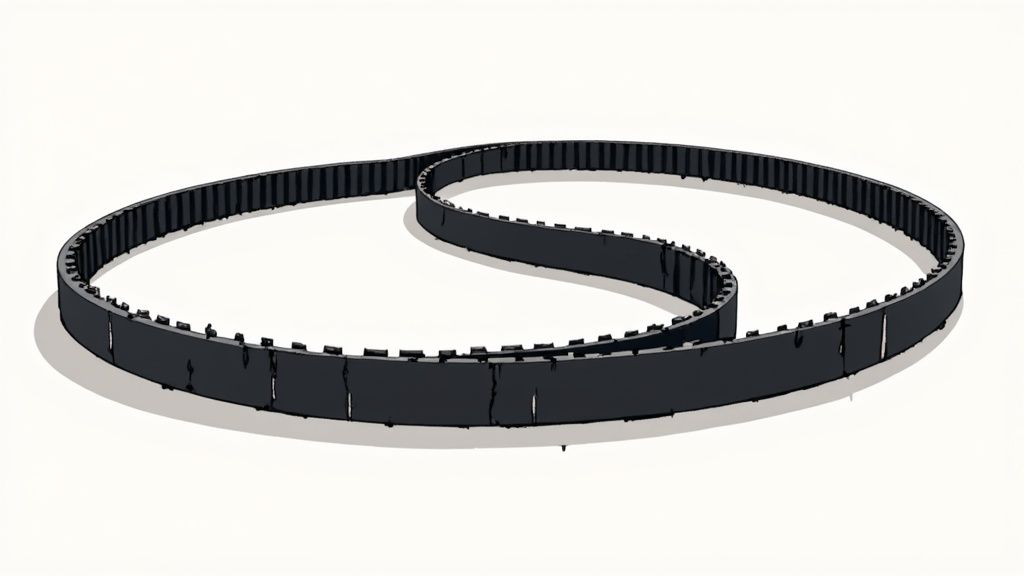
Knowing how a timing belt works is essential. But knowing when to replace it is just as critical. Manufacturer guidelines offer the most reliable advice on this vital maintenance task. These guidelines aren’t arbitrary. They are based on extensive engineering analysis, rigorous testing, and a deep understanding of how materials break down over time. Understanding these recommendations is crucial for all car owners.
Deciphering Your Owner’s Manual
Your owner’s manual is the first place to check for timing belt replacement intervals. These schedules, often displayed in tables, outline recommended replacement intervals based on both mileage and time. For instance, a manufacturer might recommend replacing the timing belt every 90,000 miles or 7 years, whichever comes first.
These intervals consider factors like engine design, typical operating conditions, and the specific materials used in the timing belt. Carefully tracking these milestones is vital to prevent potential engine damage. Using a service record tool can help you stay organized and ensure you never miss a crucial timing belt replacement.
Timing belts need regular replacement to avoid engine problems. Manufacturers generally recommend replacing them every 60,000 to 100,000 miles, or after a set number of years. For example, Hyundai recommends replacement at 48 months or 60,000 miles, with adjustments for severe driving conditions.
This proactive approach is crucial. A broken timing belt can severely damage engine components like valves and pistons. This can lead to repair costs of $2,000 to $5,000. Learn more about timing belt replacement intervals: How Do I Know When To Replace My Timing Belt?
Why Intervals Vary: From Toyota To BMW
You’ll find that timing belt replacement intervals differ between car manufacturers. Toyota often recommends a 90,000-mile interval for some models, while BMW might suggest a 50,000-mile interval for certain engines. This isn’t random.
Engine design plays a significant role. High-performance engines operating at higher RPMs and temperatures need more frequent replacements. The timing belt’s materials also affect its lifespan. Different compounds and reinforcements have varying resistance to wear, heat, and oil. Following manufacturer-specific guidelines for your vehicle is essential.
The Cost Of Prevention Vs. The Price Of Failure
Following manufacturer guidelines for timing belt replacement might seem like an upfront expense. However, this proactive maintenance is minimal compared to the potential consequences of a broken belt. A snapped timing belt can cause major engine damage, leading to expensive repairs or even engine replacement.
The cost of a timing belt replacement is a small fraction of the price of fixing a damaged engine. By diligently following manufacturer guidelines and tracking your vehicle’s maintenance, you can avoid significant costs and keep your engine running smoothly.
Age vs. Mileage: The Hidden Timing Belt Debate
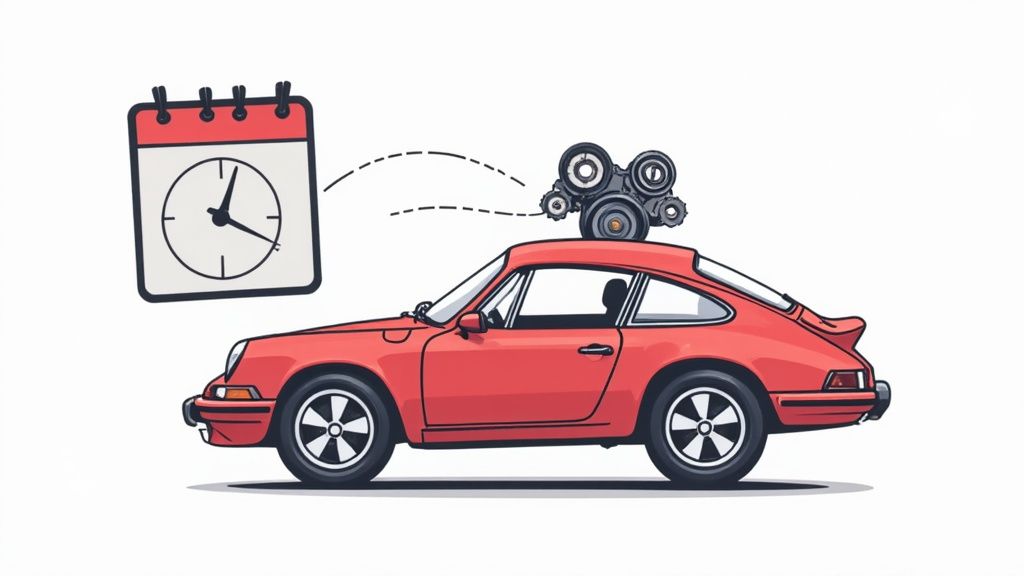
You meticulously track your car’s mileage, ensuring regular oil changes and maintenance. But are you forgetting a vital component of your engine’s longevity? This piece explores the crucial question: should your timing belt replacement be based on age or mileage?
The Silent Degradation of Your Timing Belt
Mileage contributes to timing belt wear, but age plays a significant, often overlooked role. Imagine a rubber band. Over time, even unused, it loses its elasticity and can crack. Your timing belt, also made of rubber, behaves similarly. Continuous exposure to temperature fluctuations, humidity, and pollutants causes degradation, irrespective of mileage. This means a low-mileage, garage-kept car can still be susceptible to timing belt failure.
Consider two identical cars: one driven daily in moderate conditions, and another stored in a fluctuating climate. The latter, despite lower mileage, might have a more deteriorated timing belt due to environmental factors. This underscores the impact of time on timing belt health.
Environmental Factors and Timing Belt Lifespan
Your location matters. A timing belt in Arizona’s intense heat and UV exposure will age differently than one in Minnesota’s freezing winters. These temperature swings accelerate degradation. Humidity also contributes, increasing the risk of dry rot and cracking. The timing belt is essential for engine function, making its condition paramount.
Replacing a timing belt based on mileage or age depends on various factors. While some manufacturers recommend mileage-based replacements, others consider age. A low-mileage car several years old might still require a timing belt replacement due to age-related deterioration. Timing belt failure can occur without warning, leading to expensive repairs. Learn more: Timing Belt Replacement by Vehicle Age vs. Mileage
A Practical Approach to Decision-Making
How do you decide when to replace your timing belt? First, check your owner’s manual for manufacturer recommendations on mileage and age. Second, consider your driving conditions and environment. In extreme temperatures or high humidity, replace the belt sooner. Finally, if your car is over six years old, regardless of mileage, have a qualified mechanic inspect it. Tools like Auto Service Logger can help track your maintenance history and inform these decisions. This proactive approach can prevent unexpected failures and save you money in the long run.
Recognizing the Warning Signs Before Catastrophic Failure
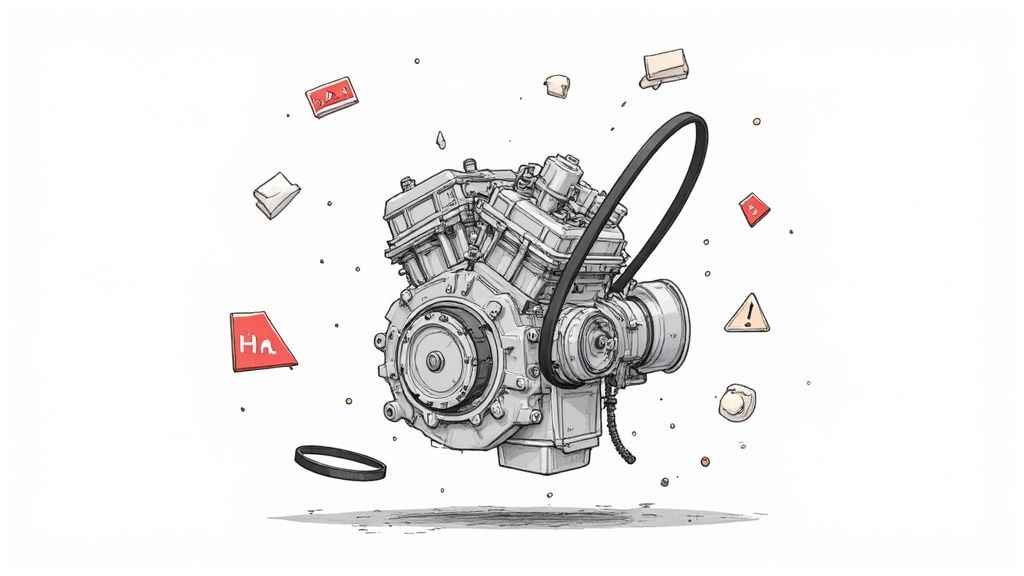
A failing timing belt can manifest in several ways, ranging from subtle hints to glaring red flags. Understanding these signs is critical to avoiding significant engine damage. This involves being attuned to your vehicle and recognizing the signals it’s sending.
Disregarding these warnings can result in substantial repair costs that could have been easily prevented with proactive maintenance.
Listening to Your Engine: Ticking and Other Sounds
One of the most prevalent indicators of a failing timing belt is a ticking sound emanating from the engine. This ticking, often rhythmic in nature, typically increases in intensity with engine speed. This points to a worn timing belt nearing the end of its lifespan.
Other unusual sounds, such as squealing or grinding, may indicate misalignment or damage to associated components. These auditory cues should never be ignored and warrant immediate inspection.
Performance Issues: Starting and Idling Problems
Beyond unusual sounds, your engine’s performance can provide valuable diagnostic information. Difficulty starting or rough idling is often linked to timing belt wear. For instance, the engine might crank slowly or require multiple attempts to start.
This is a consequence of incorrect timing disrupting the precise synchronization of the combustion process. A noticeable decline in engine power and fuel economy can also indicate a timing belt issue.
Visual Inspection: Cracks and Wear
A visual examination of the timing belt itself, if accessible, provides definitive evidence of its condition. Obvious cracks, fraying, or missing teeth signal a compromised belt requiring urgent attention.
Accessing the timing belt usually necessitates removing other engine components. This complexity makes visual checks best suited for trained mechanics during scheduled maintenance. Importantly, even if the belt appears visually sound, internal damage can be present. This emphasizes the importance of following the manufacturer’s recommended replacement intervals.
Modern Engines and Masked Symptoms
Modern engine designs, which prioritize quiet operation, can sometimes mask the audible symptoms of a failing timing belt. This can result in sudden and unexpected failure, leading to extensive engine damage.
Ignoring unusual noises or performance changes can quickly transform a relatively inexpensive preventative maintenance task into a repair costing upwards of $3,000. Maintaining meticulous service records, potentially using tools like Auto Service Logger, ensures timely timing belt replacements, preventing catastrophic failure and exorbitant repair bills.
The following table summarizes common timing belt warning signs, their detection methods, severity levels, and recommended actions. This will help you quickly assess potential issues and take the appropriate steps.
Common Timing Belt Warning Signs
| Warning Sign | Detection Method | Severity Level | Recommended Action |
|---|---|---|---|
| Ticking sound | Auditory | High | Immediate inspection |
| Squealing/Grinding | Auditory | High | Immediate inspection |
| Difficulty starting | Sensory | High | Immediate inspection |
| Rough idling | Sensory | High | Immediate inspection |
| Decreased power | Sensory | Medium | Inspection within 1-2 days |
| Reduced fuel efficiency | Sensory | Medium | Inspection within 1-2 days |
| Visible cracks/wear | Visual | Critical | Immediate replacement |
By recognizing these warning signs and taking prompt action, you can safeguard your engine and avoid the significant financial burden of a broken timing belt.
Understanding the True Cost of Timing Belt Replacement
Replacing a timing belt is more than just swapping out a single part. It’s a labor-intensive job often requiring the replacement of other essential components. Knowing what’s involved can help you budget effectively and make informed decisions.
Why Labor Costs Dominate the Repair Bill
The timing belt itself is relatively inexpensive. However, labor often accounts for up to 70% of the total cost. This is because accessing the timing belt requires significant disassembly. Mechanics often need to remove components like the fan, radiator, and other belts to get to it.
This intricate work demands skilled labor and specialized tools, driving up the overall expense.
Engine Complexity and Its Effect on Price
The complexity of your engine also influences the final price. Engines with more intricate designs, tighter clearances, and numerous components require more time and effort to service. This leads to higher labor costs.
For instance, replacing a timing belt on a V6 engine is typically more costly than on a four-cylinder engine due to the added complexity and parts involved.
Replacing Related Components: Water Pump and More
Along with the timing belt, experienced mechanics often recommend replacing related components simultaneously. The water pump, commonly driven by the timing belt, is a key example. Since accessing the water pump involves similar disassembly as the timing belt, replacing both at once avoids redundant labor costs down the line.
Other parts like tensioners, idler pulleys, and cam/crankshaft seals are also often replaced proactively. While increasing the initial cost, this preventative approach saves money and avoids potential headaches by preventing separate repairs later. Neglecting these components can lead to premature timing belt failure and potentially catastrophic engine damage.
Comparing Costs: Dealerships Versus Independent Shops
Understanding the cost variations between service providers is crucial. In the US, the average timing belt replacement cost ranges from $580 to $1,400, depending on factors like vehicle make and model, labor rates, and location. For more details, explore this topic further. In major cities like New York, costs can range from $700 to $1,400. Smaller cars, however, might cost around $310 due to easier access.
Dealerships typically charge more than independent shops due to higher overhead. Chain repair shops often fall somewhere in between. Obtaining quotes from multiple sources—dealerships, chain shops, and independent mechanics—enables you to compare pricing and make an informed decision. Don’t hesitate to negotiate, especially with independent shops. Meticulous record-keeping with a tool like Auto Service Logger can bolster your negotiating position.
To help illustrate the potential cost differences, let’s look at a comparison table:
Timing Belt Replacement Cost Comparison
This table compares the typical timing belt replacement costs across different vehicle categories and service provider types.
| Vehicle Type | Dealer Cost Range | Independent Shop Cost Range | Additional Components |
|---|---|---|---|
| Compact Car | $700 - $1,000 | $400 - $600 | Water pump, tensioner |
| Mid-size Sedan | $900 - $1,200 | $550 - $800 | Water pump, tensioner, idler pulley |
| SUV | $1,100 - $1,400 | $700 - $1,000 | Water pump, tensioner, idler pulley, cam/crankshaft seals |
| Luxury Vehicle | $1,400+ | $900+ | Water pump, tensioner, idler pulley, cam/crankshaft seals, other related components |
As the table demonstrates, independent shops consistently offer lower prices than dealerships across all vehicle types. The additional components listed are commonly recommended for replacement at the same time as the timing belt.
The High Cost of Procrastination
The most significant factor influencing cost is when you replace your timing belt. Proactive replacement, as recommended by the manufacturer, is far less expensive than dealing with the consequences of a broken belt. A snapped timing belt can cause catastrophic engine damage, potentially leading to thousands of dollars in repairs or even a complete engine replacement.
View a timing belt replacement as an investment—insurance against far greater expenses down the road. Regularly documenting your vehicle’s maintenance using Auto Service Logger helps you track recommended replacement intervals and avoid the disastrous consequences of a broken timing belt.
DIY or Professional: Making the Right Call For Your Vehicle Timing Belt
Thinking about tackling your timing belt replacement yourself? This article offers a realistic perspective on when a DIY approach makes sense, and when it’s best left to the experts. We’ll explore the complexities of this vital maintenance task and help you make the informed decision that’s best for your vehicle and your peace of mind.
The Allure (and Risks) of DIY Timing Belt Replacement
The DIY route is undeniably tempting, particularly considering the potentially high labor costs at a repair shop. However, timing belt replacement is not a straightforward procedure. Even experienced DIY mechanics can encounter difficulties, and mistakes can have serious repercussions for your engine.
Timing Belt Tension: A Critical Factor
Proper timing belt tensioning is essential. Simply following the steps in a repair manual isn’t sufficient. Achieving the correct tension requires experience, a keen understanding of engine mechanics, and specialized tools like a belt tension gauge. A blog post detailing a DIY timing belt replacement on a Toyota Tacoma underscores the importance of these tools, listing several essential SSTs (Special Service Tools) including a tension gauge, seal puller, and pulley holding tool. The author emphasizes these tools, while an added expense, are vital for a successful and safe repair. Incorrect tension can lead to premature wear, slippage, or even a complete break, potentially causing catastrophic engine damage.
Inside a Professional Timing Belt Replacement
Professional mechanics employ a systematic approach when replacing a timing belt. They possess a deep understanding of engine timing principles and have the right tools and expertise to prevent costly errors. Here’s a simplified overview of their typical workflow:
-
Precise Alignment: Ensuring perfect alignment of the crankshaft and camshaft is paramount. This involves using specific timing marks and specialized tools.
-
Proper Tensioning: Mechanics use precision tension gauges and their experience to achieve the correct belt tension.
-
Component Replacement: Often, associated components like the water pump, tensioner, and idler pulleys are replaced at the same time. This proactive strategy saves time and money down the road.
-
Verification and Testing: After installation, the timing is verified, and the engine is tested to ensure proper function.
These steps, while seemingly simple, demand specialized knowledge and tools. Attempting them without proper training can lead to significant problems.
Selecting a Qualified Mechanic
If you choose professional service, selecting a qualified technician is crucial. Here are some important questions to ask:
-
Experience: What’s their experience with timing belt replacements on your specific vehicle make and model?
-
Warranty: What type of warranty do they offer on their labor and parts?
-
References: Can they provide references or testimonials?
-
Documentation: Will they provide detailed documentation of the completed work, including the parts used? This is essential for warranty claims and affects your vehicle’s resale value.
Preparing for Timing Belt Replacement: A Practical Checklist
Whether you opt for DIY or professional service, preparation is key. Here’s a checklist to get you started:
-
Consult Your Owner’s Manual: Confirm the recommended replacement interval for your specific vehicle.
-
Gather Quotes: Get quotes from several service providers if you are going with a mechanic to compare pricing and services.
-
Research Parts: If tackling the job yourself, buy high-quality parts from reputable suppliers.
-
Set Aside Adequate Time: This isn’t a quick job. Allocate enough time, especially for a DIY project.
-
Arrange Backup Transportation: Have alternate transportation lined up if your vehicle will be unavailable for an extended period.
By following this checklist and carefully weighing the DIY versus professional options, you can make a smart decision that safeguards your engine and your budget.
Simplify Your Vehicle Maintenance Tracking
Ready to take charge of your vehicle maintenance and ensure you never overlook a crucial timing belt replacement? Auto Service Logger offers a centralized platform for logging, storing, and accessing all your vehicle maintenance records. Explore Auto Service Logger and streamline your maintenance tracking today!